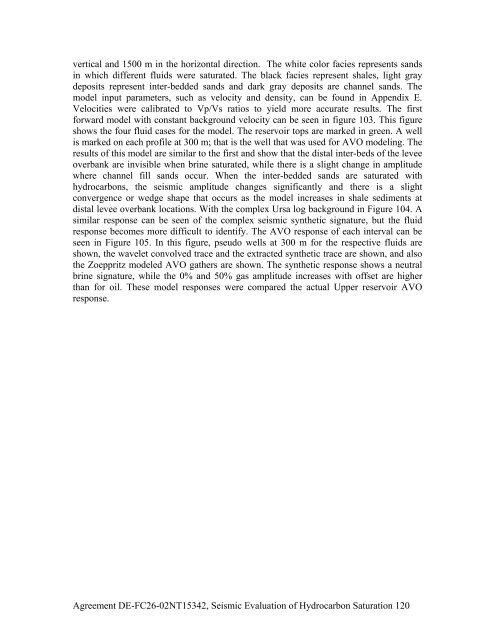Agreement DE-FC26-02NT15342, Seismic Evaluation of ...
Agreement DE-FC26-02NT15342, Seismic Evaluation of ...
Agreement DE-FC26-02NT15342, Seismic Evaluation of ...
You also want an ePaper? Increase the reach of your titles
YUMPU automatically turns print PDFs into web optimized ePapers that Google loves.
vertical and 1500 m in the horizontal direction. The white color facies represents sands<br />
in which different fluids were saturated. The black facies represent shales, light gray<br />
deposits represent inter-bedded sands and dark gray deposits are channel sands. The<br />
model input parameters, such as velocity and density, can be found in Appendix E.<br />
Velocities were calibrated to Vp/Vs ratios to yield more accurate results. The first<br />
forward model with constant background velocity can be seen in figure 103. This figure<br />
shows the four fluid cases for the model. The reservoir tops are marked in green. A well<br />
is marked on each pr<strong>of</strong>ile at 300 m; that is the well that was used for AVO modeling. The<br />
results <strong>of</strong> this model are similar to the first and show that the distal inter-beds <strong>of</strong> the levee<br />
overbank are invisible when brine saturated, while there is a slight change in amplitude<br />
where channel fill sands occur. When the inter-bedded sands are saturated with<br />
hydrocarbons, the seismic amplitude changes significantly and there is a slight<br />
convergence or wedge shape that occurs as the model increases in shale sediments at<br />
distal levee overbank locations. With the complex Ursa log background in Figure 104. A<br />
similar response can be seen <strong>of</strong> the complex seismic synthetic signature, but the fluid<br />
response becomes more difficult to identify. The AVO response <strong>of</strong> each interval can be<br />
seen in Figure 105. In this figure, pseudo wells at 300 m for the respective fluids are<br />
shown, the wavelet convolved trace and the extracted synthetic trace are shown, and also<br />
the Zoeppritz modeled AVO gathers are shown. The synthetic response shows a neutral<br />
brine signature, while the 0% and 50% gas amplitude increases with <strong>of</strong>fset are higher<br />
than for oil. These model responses were compared the actual Upper reservoir AVO<br />
response.<br />
<strong>Agreement</strong> <strong>DE</strong>-<strong>FC26</strong>-<strong>02NT15342</strong>, <strong>Seismic</strong> <strong>Evaluation</strong> <strong>of</strong> Hydrocarbon Saturation 120
















